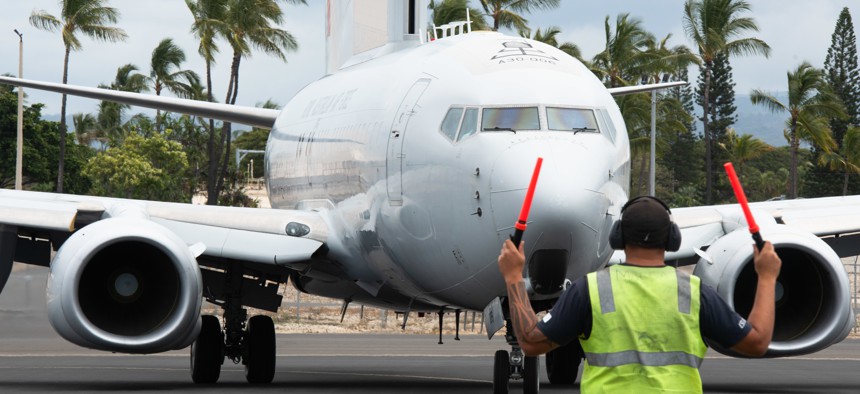
A Royal Australian Air Force E-7A Wedgetail, operated by No. 2 Squadron, based at RAAF Base Williamtown, Australia, is marshaled into a parking spot April 20, 2021, at Joint Base Pearl Harbor-Hickam, Hawaii. Hawaii Air National Guard / Staff Sgt. John Linzmeier
Where’d the Money Go? Lawmakers Press Air Force on Planned Radar Plane
Congress approved $200 million last year to get the first E-7s faster. That’s not happening.
Congress gave money to the U.S. Air Force to speed up E-7 Wedgetail production. Now lawmakers are wondering where it went, since the first aircraft won’t be delivered any sooner.
Lawmakers allocated an additional $200 million in last year’s defense policy bill to accelerate the production of two U.S. prototypes of the battle management and command-and-control aircraft, the first of which was—and is—scheduled for delivery in 2027.
Under questioning by Sen. Jack Reed, D-R.I., and Sen. Roger Wicker, R-Miss., Air Force Secretary Frank Kendall said the program is moving “as fast as we're able to move it. I did a personal review of the steps that are necessary to get into the first phase of testing and we couldn't find a way to redo that.”
The service used the funds to speed up contractor hiring and start engineering and design efforts, said Andrew Hunter, the Air Force’s top weapons buyer.
“The congressional add also allowed us to do some things earlier in the program, including fund the procurement of the 737-700 aircraft, radar, and modification kit long lead hardware; critical engineering reviews; and early software demonstrations and test planning. Further, we will be able to fund incentives in the contract that would help us keep to our aggressive schedule to field this capability,” Hunter said in a statement.
While the Air Force couldn’t find a way to speed up initial production, “the one thing that could be done would be to add funding that would accelerate the production of the follow-on units—not the first one, but the follow-on ones—but we were not able to afford that in our budget,” Kendall said Thursday during a Senate Armed Service committee hearing.
Now the service is asking Congress for an additional $633 million to accelerate the delivery of two E-7s, according to this year’s “unfunded list” of programs that didn’t make it into the Air Force’s $185 billion 2024 spending request. If Congress accedes, service officials said, they would get two E-7s in 2025 instead of one. The money would cover long-lead items for the “green” 737 body—the aircraft itself without any modifications—and the E-7’s multirole electronically scanned array, or MESA, radar.
Pentagon officials have said they need E-7s in the Indo-Pacific region to handle airborne domain awareness and to maintain air superiority—particularly if the Air Force is allowed to retire two E-3 Sentry AWACS-carrying radar planes. Service leaders are reupping their request after Congress denied it last year. Kendall previously told reporters that “we’re not losing a lot” by retiring the E-3s before the E-7 arrives because the E-3 sensors are “pretty ancient” and the aircraft are expensive to maintain.
While the first E-7 won’t be delivered anytime soon, Kendall said the service is planning on buying three aircraft in 2026, up from its initial plans to only buy two. The service eventually wants 26 E-7s.
“We get more inventory into the hands of people faster than we would have with the profile we have initially proposed, but you don’t get the first aircraft faster,” Kendall said.
Australia has been flying E-7s for years, but Kendall said there are differences between the two versions. The service is working with Australia to upgrade the E-7 and “enhance its capabilities,” he said.
If Australia is already operating the aircraft “very effectively,” Wicker asked why the U.S. E-7 program can’t be accelerated.
Kendall said the Air Force is buying new production aircraft that need to be “modified to put the radar and command and control systems inside them, so in order to preserve air-worthiness, you have to actually acquire the commercial aircraft and then open it up to insert the other things that you need to put in it.”
In June, the service will send 50 to 60 airmen to Australia to “start training on the E-7s so when we do get our aircraft, we’ll have trainers, operators, and maintainers to help accelerate bringing the E-7 into our inventory,” Air Force Chief of Staff Gen. CQ Brown said during the hearing.




